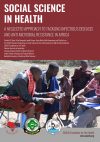Dr Eva Steliarova, Scientist at IARC’s Section of Cancer Surveillance explains how research results can be used to reduce the burden of cancer in children
IARC’s international study on the incidence of cancer in childhood found a global increase of 13% in childhood cancer between 2001-2010 compared to the 1980s. The percentage increase compares the incidence rates of 124 per million for the earlier period and 141 per million for the more recent one. With the exception of sub-Saharan Africa, the increase affected all the world regions we studied, and ranged between 3% (Central America and Caribbean) and 30% (Southeast Asia). What could this increase be attributed to?
The challenge of data collection
Although the 2 studies used comparable methods and provided the best estimates of incidence for their respective periods, the covered populations differed. Data were not available for some areas included in the earlier study, while new areas were included in the more recent statistics.
It was important to ensure that data collected in different countries are comparable, so that we can draw conclusions from the observed differences in incidence rates. The established data flow system, motivated staff in cancer registries around the world, a set of international standards and extensive communication between the contributors were required for conducting this study. Our main aim was to define the level of cancer occurrence in the young populations, the most important determinant for cancer control planning and for further research into the causes of cancer in this young population. The produced information does not suffice, however, to explain the causes of the observed patterns. Further focused investigations are required in this direction.
The role of improved diagnosis
Future detailed examination of the incidence trends for specific cancer types could indicate the role of improved diagnosis. For example, a rise in the CNS tumours could be attributed to the implementation of magnetic resonance imaging (MRI) in the 1980s in high-resource countries, and their gradual uptake in less privileged areas. The lack of CNS tumours as well as sophisticated imaging technology on the African continent supports indirectly the role of diagnosis in the temporal trends. Over the time, diagnoses are increasingly based on molecular and genetic analyses, new entities are being recognised and changes in tumours classification proposed. More tumours may be counted as malignant. The novel imaging techniques may detect tumours earlier in life, which would contribute to higher rates within the childhood age-range. On the other hand, the increase in incidence rates was seen in the areas with advanced, as well as with developing diagnostic facilities, which may suggest that the improved diagnosis does not explain the observed increase entirely.
Improved awareness and referral system
More cancers may be detected also because of improved awareness among primary healthcare providers and more frequent referral of suspected cancers for correct diagnosis and treatment. The role of professional associations such as the International Society of Paediatric Oncology (SIOP), as well as charitable actions of patients’ families may drive a better or faster access to diagnostic facilities.
Registration of diagnosed cases might have improved with the accumulation of local expertise and maturation of international cooperation. A legal requirement to register (childhood) cancer cases, instituted in numerous registration areas during the 3 decades would definitely enhance the registration completeness.
A role of exposure to risk factors?
The data assembled in our study cannot confirm or refute an increased exposure to various risk factors of childhood cancer identified in other studies. The early life onset and the association of some childhood cancers with a number of inherited syndromes may explain some 5% of cancers in children. Multiple external risk factors have also been examined. While ionising radiation from atomic bombs, industrial accidents or medical interventions may cause leukaemia, thyroid and possibly other childhood cancers, the levels and opportunities of these exposures are relatively limited, as is the proportion of cases due to radiation. Some wide-spread viruses (Epstein-Barr or Human immunodeficiency virus, HIV) together with other co-factors may also lead to cancer development, such as Burkitt lymphoma or Kaposi sarcoma, both highly prevalent in sub-Saharan Africa. Environmental pollution, exposure to pesticides or other carcinogens and some dietary constituents of children or their parents were also associated with childhood cancer in some studies, but not in others. The barriers to a better knowledge of the causes lie in the low frequency of cancer in children, difficulty of accurate exposure assessment, as well as in isolation of potential risk factors from the multitude of simultaneous exposures.
Geographical and ethnic differences in childhood cancer occurrence
Our large international study characterises the geographical and ethnic differences in childhood cancer occurrence and suggests possible associations worthy of further study. One example may be the high relative incidence of childhood leukaemia in South-East Asia, the area which is also known for the wide-spread use of pesticides in agriculture. Another illustration is the drop in the incidence rates in sub-Saharan Africa, at least in part attributed to a reduction of HIV infection load through antiretroviral therapy in the exposed childhood population. This observation implies that external factors may be involved in childhood cancer development and also that preventive measures may result in a reduction of incidence.
Cancer prevention and control is a recognised priority by the WHO1 and integrates continued surveillance to help with planning childhood cancer care. Our study also serves as a springboard for detection of associations which, if confirmed, may lead to taking preventive actions and possibly reducing childhood cancer incidence in the future.
The International Agency for Research on Cancer (IARC) the specialised agency of the WHO, is coordinating the International Incidence of Childhood Cancer study in collaboration with International Association of Cancer Registries (IACR) and with a financial support of The Union for International Cancer Control (UICC). The first bulk of results of the study were released online on the occasion of the International Childhood Cancer Day on 15 February 2017 and at http://iicc.iarc.fr/ and they will be followed by a printed publication later in 2017 with a complete background on data sources and methods. An overview paper summarising and interpreting the main findings by world regions for period 2001-2010 was published in June by The Lancet Oncology.
About the author
Dr Eva Steliarova is a senior scientist, at IARC’s Section of Cancer Surveillance. She coordinates the work on the third volume of the International Incidence of Childhood Cancer (IICC-3), presented at http://iicc.iarc.fr/ and other international studies of cancer in children. She relies on active collaboration of hundreds of data contributors, the international boards of advisors and editors, as well as the support by her IARC colleagues.
1 http://apps.who.int/gb/ebwha/pdf_files/WHA70/A70_R12-en.pdf
Dr Eva Steliarova
Scientist
Section of Cancer Surveillance – International Agency for Research on Cancer (IARC)

























